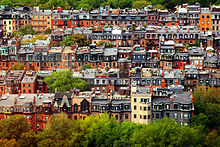Our website is made possible by displaying online advertisements to our visitors.
Please consider supporting us by disabling your ad blocker.
Building typology

Building typology refers to building and documenting buildings according to their essential characteristics. In architectural discourse, typological classification tends to focus on building function (use), building form, or architectural style. A functional typology collects buildings into groups such as houses, hospitals, schools, shopping centers, etc. A formal typology groups buildings according to their shape, scale, and site placement, etc. (Formal building typology is also sometimes referred to as morphology (gk. morph).) Lastly, a stylistic typology borrows from art history and identifies building types by their expressive traits, e.g. Doric, Ionic, Corinthian (subtypes of classical), baroque, rococo, gothic, arts and crafts, international, post-modern, etc.
The three typological practices are interlinked. Namely, each functional type consists of many formal types. For example, the residential functional type may be split into formal categories such as the high rise tower, single family home, duplex, or townhouse. Similarly, while certain stylistic traits may be considered superfluous to a formal building type, style and form are nonetheless related since the conditions (political, economic, technological) that give rise to stylistic traits also enable or encourage certain forms to be expressed. In all three cases the typology serves as a framework for understanding the essential qualities of buildings on conceptually equal footing, apart from their individual, contingent characteristics.
Previous Page Next Page


